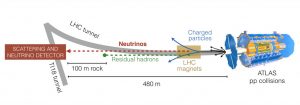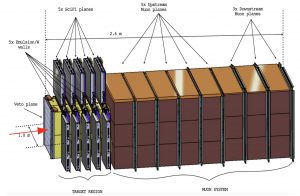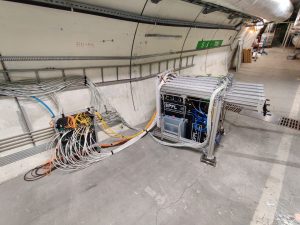The Scattering and Neutrino Detector at the Large Hadron Collider (SND@LHC) at CERN is an experiment designed to detect and study for the first time neutrinos produced at a particle collider together with the FASER experiment. The detector is installed in the TI18 tunnel approximately 500 m off-axis of the interaction point (IP) of the ATLAS experiment.

This position allows to measure neutrinos in the previously unexplored pseudo-rapidity range 7.2 < η < 8.6. The 100 m of rock ensures all residual hadrons from the ATLAS IP are unable to reach the detector. Additionally, SND@LHC is suited to look for dark matter candidates known as Feebly Interacting Particles (FIPs), which are not predicted by the Standard Model of particle physics.
The neutrinos interacting at the SND@LHC detector will be detected in the target region, which consists of tungsten plates interleaved with emulsion films and an electronic tracking device. The emulsion films are chosen for their excellent spatial resolution and will determine the particle path with micrometrical accuracy. The electronic tracking device is a Scintillating Fibre (SciFi) tracker, and will add an accurate time stamp to the particle tracks detected by the emulsion films. The SciFi tracker is followed by the muon detection system, which is made of eight iron walls interleaved with scintillating bars. Together with a Veto plane upstream of the target region it will be able distinguish between muons originating from particle interactions of the ATLAS IP and muons produced by neutrino interactions. The electronic tracker and the muon system are also used as a calorimeter to determine the particle’s energy.


The SND@LHC detector is ready to take data with the LHC restarting in spring 2022. For more information on the experiment visit the website https://snd-lhc.web.cern.ch/about-sndlhc !